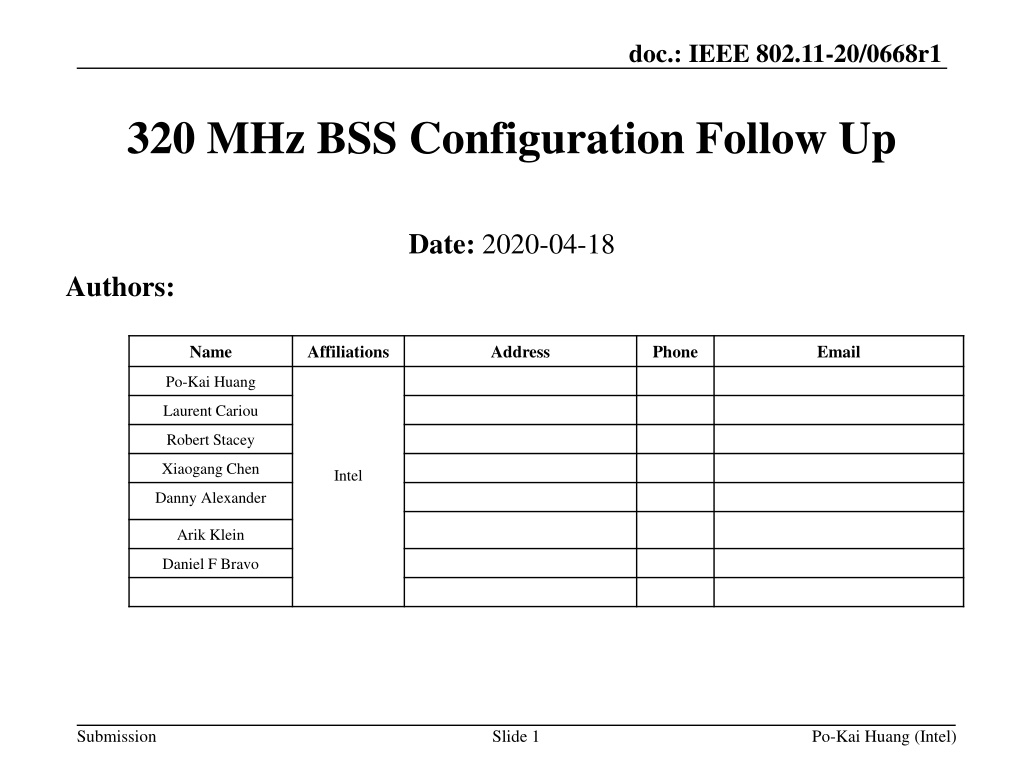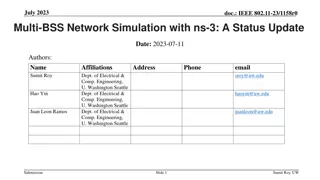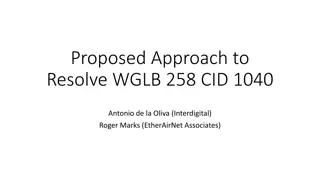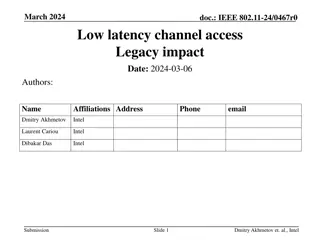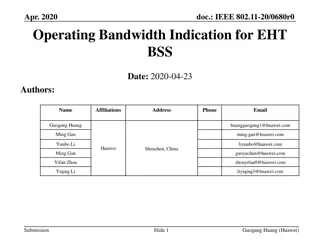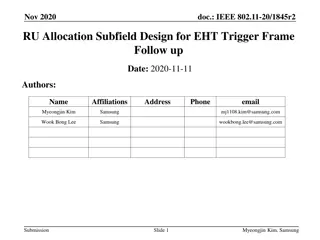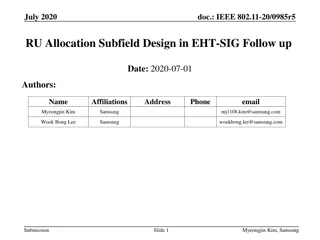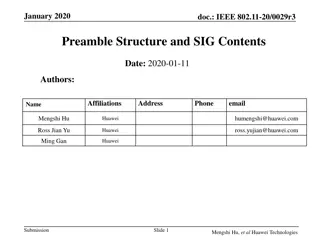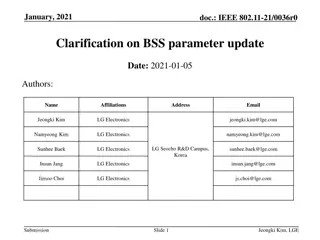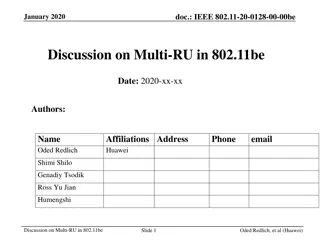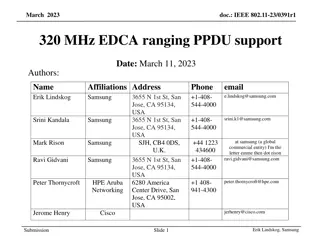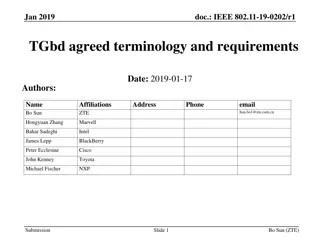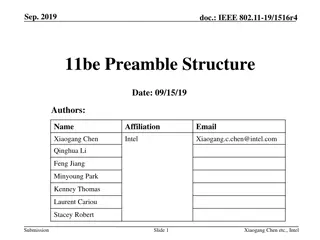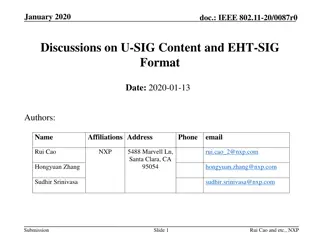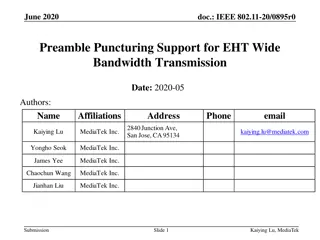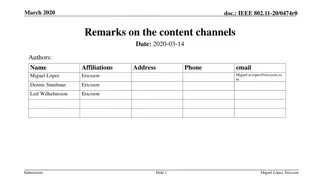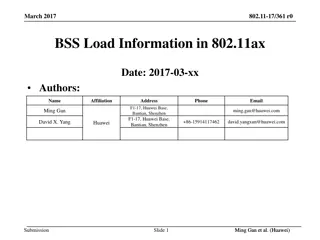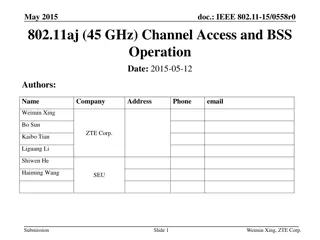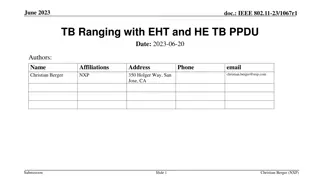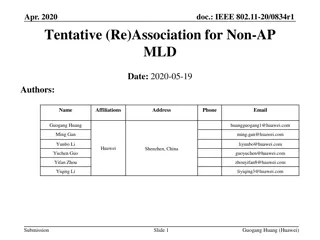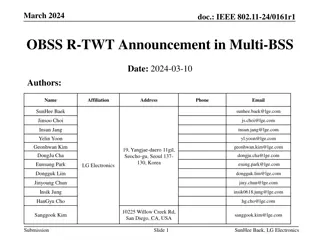IEEE 802.11-20/0668r1: EHT BSS Configuration Proposal
The document discusses the configuration of a 320 MHz BSS in the context of 6 GHz regulations, focusing on EHT operation elements such as channel width indication, CCFS principles, and BSS advertisement settings. It proposes design principles for managing legacy and EHT STA operations, emphasizing simplicity and clarity in the 6 GHz environment.
Download Presentation

Please find below an Image/Link to download the presentation.
The content on the website is provided AS IS for your information and personal use only. It may not be sold, licensed, or shared on other websites without obtaining consent from the author.If you encounter any issues during the download, it is possible that the publisher has removed the file from their server.
You are allowed to download the files provided on this website for personal or commercial use, subject to the condition that they are used lawfully. All files are the property of their respective owners.
The content on the website is provided AS IS for your information and personal use only. It may not be sold, licensed, or shared on other websites without obtaining consent from the author.
E N D
Presentation Transcript
doc.: IEEE 802.11-20/0668r1 320 MHz BSS Configuration Follow Up Date: 2020-04-18 Authors: Name Affiliations Address Phone Email Po-Kai Huang Laurent Cariou Robert Stacey Xiaogang Chen Intel Danny Alexander Arik Klein Daniel F Bravo Submission Slide 1 Po-Kai Huang (Intel)
doc.: IEEE 802.11-20/0668r1 Background We discuss 320 MHz BSS configuration in the past[1] The latest development in 6 GHz regulatory suggests that there may be SP AFC AP, and certain 20 MHz maybe restricted for usage (disallowed or power limit) We expect that the most common operation is LPI mode due to uncertainty of AFC management There is no need for static puncturing in LPI mode Nevertheless, we discuss how we can manage 320 MHz BSS advertisement for legacy and EHT STA for SP AFC AP. For example, advertise 20 for legacy due to 20 MHz restriction and 40/80/160 or 80+80/320 or 160+160 for EHT STA Note that this proposal is only needed in 6 GHz Submission Slide 2 Po-Kai Huang (Intel)
doc.: IEEE 802.11-20/0668r1 General Design Principle In EHT operation element Have Channel Width to indicate 20/40/80/160 or 80+80/320 or 160+160 Have EHT CCFS0 with same indication principle of CCFS0 in HE operation element when Channel Width indicates 20/40/80/160 or 80+80 Have EHT CCFS1 with same indication principle of CCFS1 in HE operation element when Channel Width indicates 20/40/80/160 or 80+80 May utilize additional CCFS to indicate center of 320 or center of secondary 160 or reuse CCFS 0 and CCFS 1 to Indicate center of primary 160 and center of 320 for 320 Indicate center of primary 160 and secondary 160 If the EHT BSS configuration is larger than the BSS configuration for legacy STA Simply looking at the EHT operation element as one place for all the indication Avoid complicated linking with the legacy indication in 6 GHz for whatever scenario Submission Slide 3 Po-Kai Huang (Intel)
doc.: IEEE 802.11-20/0668r1 Advertisement in 6 GHz EHT BSS Configuration Legacy BSS Configura tion Setting Setting Setting 20 Channel Width: 20 CCFS0: center of 20 CCFS1: 0 20 Channel width: 20 EHT CCFS0: center of 20 EHT CCFS1: 0 Channel width: 20 EHT CCFS0: center of 20 EHT CCFS1: 0 EHT CCFS: 0 20 Channel Width: 20 CCFS0: center of 20 CCFS1: 0 40 Channel width: 40 EHT CCFS0: center of 40 EHT CCFS1: 0 Channel width: 40 EHT CCFS0: center of 40 EHT CCFS1: 0 EHT CCFS: 0 20 Channel Width: 20 CCFS0: center of 20 CCFS1: 0 80 Channel width: 80 EHT CCFS0: center of 80 EHT CCFS1: 0 Channel width: 80 EHT CCFS0: center of 80 EHT CCFS1: 0 EHT CCFS: 0 20 Channel Width: 20 CCFS0: center of 20 CCFS1: 0 160/80+80 Channel width: 160/80+80 EHT CCFS0: center of primary 80 EHT CCFS1: center of 160 or secondary 80 Channel width: 160/80+80 EHT CCFS0: center of primary 80 EHT CCFS1: center of 160 or secondary 80 EHT CCFS: 0 20 Channel Width: 20 CCFS0: center of 20 CCFS1: 0 320/160+160 Channel width: 320/160+160 EHT CCFS0: center of primary 160 EHT CCFS1: center of 320 or secondary 160 Channel width: 320/160+160 EHT CCFS0: center of primary 80 EHT CCFS1: center of primary 160 EHT CCFS: center of 320 or secondary 160 Submission Slide 4 Po-Kai Huang (Intel)
doc.: IEEE 802.11-20/0668r1 Advertisement in 6 GHz Legacy BSS Configura tion Setting EHT BSS Configuration Setting Setting 40 Channel Width: 40 CCFS0: center of 40 CCFS1: 0 40 Channel width: 40 EHT CCFS0: center of 40 EHT CCFS1: 0 Channel width: 40 EHT CCFS0: center of 40 EHT CCFS1: 0 EHT CCFS: 0 40 Channel Width: 40 CCFS0: center of 40 CCFS1: 0 80 Channel width: 80 EHT CCFS0: center of 80 EHT CCFS1: 0 Channel width: 80 EHT CCFS0: center of 80 EHT CCFS1: 0 EHT CCFS: 0 40 Channel Width: 40 CCFS0: center of 40 CCFS1: 0 160/80+80 Channel width: 160/80+80 EHT CCFS0: center of primary 80 EHT CCFS1: center of 160 or secondary 80 Channel width: 160/80+80 EHT CCFS0: center of primary 80 EHT CCFS1: center of 160 or secondary 80 EHT CCFS: 0 40 Channel Width: 40 CCFS0: center of 40 CCFS1: 0 320/160+160 Channel width: 320/160+160 EHT CCFS0: center of primary 160 EHT CCFS1: center of 320 or secondary 160 Channel width: 320/160+160 EHT CCFS0: center of primary 80 EHT CCFS1: center of primary 160 EHT CCFS: center of 320 or secondary 160 Submission Slide 5 Po-Kai Huang (Intel)
doc.: IEEE 802.11-20/0668r1 Advertisement in 6 GHz Legacy BSS Configura tion Setting EHT BSS Configuration Setting Setting 80 Channel Width: 80 CCFS0: center of 80 CCFS1: 0 80 Channel width: 80 EHT CCFS0: center of 80 EHT CCFS1: 0 Channel width: 80 EHT CCFS0: center of 80 EHT CCFS1: 0 EHT CCFS: 0 80 Channel Width: 80 CCFS0: center of 80 CCFS1: 0 160/80+80 Channel width: 160 EHT CCFS0: center of primary 80 EHT CCFS1: center of 160 or secondary 80 Channel width: 160 EHT CCFS0: center of primary 80 EHT CCFS1: center of 160 or secondary 80 EHT CCFS: 0 80 Channel Width: 80 CCFS0: center of 80 CCFS1: 0 320/160+160 Channel width: 320/160+160 EHT CCFS0: center of primary 160 EHT CCFS1: center of 320 or secondary 160 Channel width: 320/160+160 EHT CCFS0: center of primary 80 EHT CCFS1: center of primary 160 EHT CCFS: center of 320 or secondary 160 Submission Slide 6 Po-Kai Huang (Intel)
doc.: IEEE 802.11-20/0668r1 Advertisement in 6 GHz Legacy BSS Configura tion Setting EHT BSS Configuration Setting Setting 160/80+80 Channel Width: 160/80+80 CCFS0: center of primary 80 CCFS1: center of 160 or secondary 80 160/80+80 Channel width: no indication EHT CCFS0: center of primary 80 EHT CCFS1: center of 160 or secondary 80 EHT CCFS: 0 Channel width: no indication EHT CCFS0: center of primary 80 EHT CCFS1: center of 160 or secondary 80 EHT CCFS: 0 160 Channel Width: 160 CCFS0: center of primary 80 CCFS1: center of 160 320/160+160 Channel width: 320/160+160 EHT CCFS0: center of primary 160 EHT CCFS1: center of 320 or secondary 160 Channel width: 320/160+160 EHT CCFS0: center of primary 80 EHT CCFS1: center of primary 160 EHT CCFS: center of 320 or secondary 160 Submission Slide 7 Po-Kai Huang (Intel)
doc.: IEEE 802.11-20/0668r1 2.4/5 GHz band Expect that we do not have SP AFC AP in 2.4/5 GHz Only need Channel Width indication and EHT CCFS for 320 MHz or 160+160 If we need indication of difference BSS bandwidth in 5 for legacy and EHT, then the solution is to add EHT CCFS2 to EHT operation element when we need to differentiate w/o Extended NSS channel width for VHT. Submission Slide 8 Po-Kai Huang (Intel)
doc.: IEEE 802.11-20/0668r1 Signaling for Channel Width indication in EHT operation element 3 bits Channel Width field in EHT operation element to indicate the following 0: 20 1: 40 2: 80 3: 160/80+80 4: 320/160+160 5: reserved 6: reserved 7: reserved The above indication aligns nicely with the indication about 6 GHz BSS configuration in HE operation element Submission Slide 9 Po-Kai Huang (Intel)
doc.: IEEE 802.11-20/0668r1 Conclusion To resolve the need of advertising all possibilities of BSS configuration to EHT STA and smaller BSS configuration to legacy HE STA, we propose to Have EHT CCFS0 and EHT CCFS1 in EHT operation element Have Channel Width field of EHT operation element indicate 20/40/80/160 or 80+80/320 or 160+160 Submission Slide 10 Po-Kai Huang (Intel)
doc.: IEEE 802.11-20/0668r1 Straw Poll Do you support the following? have at least the following indication in the Channel Width field of the EHT operation element? 20 40 80 160/80+80 320/160+160 Note Channel Width field of the EHT operation element is expected to be set inline with the channel with field of HT/VHT/HE operation element unless explicitly stated otherwise Submission Slide 11 Po-Kai Huang (Intel)
doc.: IEEE 802.11-20/0668r1 Straw Poll Do you support the following? define EHT operation element with the following fields to indicate 320/160+160 MHz BSS bandwidth Channel Width field CCFS field EHT CCFS0 field and EHT CCFS1 field Submission Slide 12 Po-Kai Huang (Intel)
doc.: IEEE 802.11-20/0668r1 Straw Poll Do you support the following? The indication of EHT CCFS0 and EHT CCFS1 when Channel Width field of the EHT operation element indicates 20, 40, 80, 160/80+80 are the same as the indication defined in 11ax for CCFS0 and CCFS1 in HE operation element when Channel Width field of the HE operation element is equal to 20, 40, 80, 160/80+80, respectively. Submission Slide 13 Po-Kai Huang (Intel)
doc.: IEEE 802.11-20/0668r1 Reference 11-20-384r1 320 MHz BSS Configuration Submission Slide 14 Po-Kai Huang (Intel)
